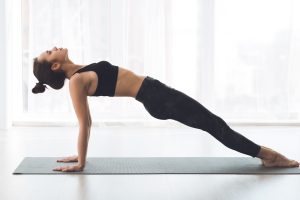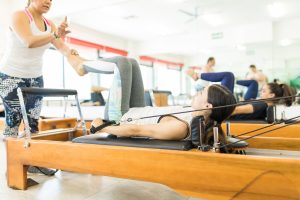Pilates 101
Get moving with this popular exercise

Pilates. Though it seems to be a buzzword these days, many of us may not know exactly what this form of exercise entails. Touted by celebs from Jennifer Aniston to Kylie Jenner, plus superstar athletes like David Beckham and Cristiano Ronaldo, it’s clearly having a resurgence.
We have everything you need to know about this uber-popular exercise — the basics, types, benefits and how to get started. Unfurl your mat and start your Pilates program now.
The Basics
So, what exactly is Pilates? It’s a low-impact exercise (a typical workout lasts around 45 minutes to an hour) that focuses on precise movements, with an emphasis on strengthening your body’s core — known as the “powerhouse” — and targeting muscles in the abdomen, lower back and hips. This improves your posture and alignment, as well as balance and flexibility. Another key element of Pilates is the mind-body connection, encouraging body awareness and focusing on your breathing.

For example, one of the most popular Pilates exercises is “The Hundred,” a warmup exercise performed lying on your back with your legs raised at a 45-degree angle. It consists of 10 reps of 10 arm pumps — five pumps inhaling, five exhaling — for a total of 100 pumps. Other common exercises include the roll up (slowly curling your body into a C-shape), single- and double-leg kicks, and planks.
Pilates is often compared with yoga. While they share similarities — precise movements, breathwork, mindful awareness — yoga started as a spiritual practice, originating in India over 5,000 years ago. In contrast, Pilates focuses primarily on physicality and is much more recent, developed by German physical trainer Joseph Pilates in the early 20th century. He conceptualized Pilates (which he called “Contrology”) while interned during World War I and later introduced the practice to dancers recovering from injuries. As a result, it’s become popular for rehabilitation, though it has benefits for people of all ages and abilities.
Of course, like any workout, Pilates comes with a few caveats. First and foremost, be sure to check with your doctor before starting Pilates. Also, expect to feel muscle burning and soreness, especially when first starting out. Some Pilates practitioners experience delayed onset muscle soreness (DOMS) a day or two after exercising.
Types of Pilates
At first, getting started with Pilates may seem daunting — what kind of Pilates should you try? What are those crazy contraptions you see at the gym? But it’s not as intimidating as it looks. There are two main types of Pilates regiments, mat Pilates and reformer Pilates. Here’s a quick overview of both, as well as a few other common variations.
As the name suggests, mat Pilates is performed on a mat — think yoga mat, but thicker. Mat Pilates exercises leverage your own body weight to build strength. It’s a great entry point for beginners due to its accessibility — it doesn’t require special equipment, it’s easy to practice at home as well as at the gym. Mat Pilates also allows newcomers to focus on learning the basic movements and techniques without the added stress of learning how to use new equipment.

Reformer Pilates, on the other hand, uses a special machine called, not surprisingly, a reformer. Invented by Joseph Pilates, it resembles a bed frame with a platform (called the carriage) on wheels that roll up and down as you move. It also has a bar on one end and a set of long, stretchy straps with handles on the other. Depending on the exercise, you may put your hands or feet on the bar, or place your feet inside the handles to use the straps with your legs. The reformer adds weight and resistance to Pilates exercises, which can be adjusted to make moves easier or more difficult. This adaptability is a major benefit of reformer Pilates, creating a customizable workout to fit your specific needs and goals.
In addition to mat and reformer Pilates, there are several other Pilates variations to explore. Joseph Pilates invented many pieces of equipment, which he called apparatus, in his lifetime. These include the Wunda (a chair with padding and springs), Magic Circle (a ring used to create resistance) and Cadillac — a table with a metal frame above it, resembling a canopy bed, used for advanced Pilates moves.
You may have also heard of TikTok’s viral wall Pilates. This at-home exercise consists of traditional Pilates moves performed against a wall, essentially acting as the reformer’s foot bar and creating a similar resistance. There’s also chair Pilates, performed seated in a kitchen or dining chair, which has been gaining in popularity, especially with older adults.
Benefits of Pilates

So, why Pilates? “If you are looking to improve your mental and physical health, Pilates is a great class to incorporate into your wellness routine,” says Jackie Canan, Senior Director of Group Exercise at the YMCA of Greater Brandywine. “Pilates provides a full-body workout, including stretching and toning exercises that improve your posture, strength and balance. Plus, you’ll increase your mindfulness with deep breathing exercises that contribute to your mental wellbeing.”
Indeed, Pilates boasts many physical and psychological benefits. With a primary aim to strengthen the core, it’s known to relieve back and hip pain, and many physical therapists recommend it for rehab. Pilates is also great for improving flexibility and mobility. Plus, the emphasis on deep breathing helps improve lung capacity and circulation, as well as increase your overall energy level.
In terms of mental health, Pilates’ focus on mindfulness and body awareness helps to relieve stress and improve concentration. Pilates is also known to improve mood. While all exercise boosts endorphins, research from the University of Limerick in Ireland suggests that Pilates specifically reduces symptoms of anxiety, depression and fatigue.
Finally, an important benefit of Pilates is its adaptability. “Best of all, Pilates can be tailored to your own abilities,” says Canan. “It’s a workout for beginners to enthusiasts and all levels in between.” Pilates workouts can be tailored to your personal goals, both physical and mental.
This winter, beat the cold-weather blues and try Pilates. Your body — and mind — will thank you.
Getting Started
Ready to try Pilates? Your local Y is a great place to start. Here are some beginner-friendly classes offered through the YMCA of Greater Brandywine.
Yoga/Pilates for Beginners. Wednesdays, 9:15 am. West Chester Area YMCA, 605 Airport Rd., West Chester.
Beginner Pilates. Wednesdays, 5:35 pm. Jennersville YMCA, 880 W. Baltimore Pk., West Grove.
Chair Pilates. Wednesdays, 1 pm. Lionville Community YMCA, 100 Devon Dr., Exton.
Virtual Pilates – LIVE. Wednesdays, 10 am. On the YMCA360 app, YMCA360.org.
Find more classes at YMCAGBW.org.
In addition to in-person sessions, you can find virtual Pilates classes (both live and pre-recorded) on apps like YMCA360, Pilates Anytime and Peloton, or on websites like YouTube.
